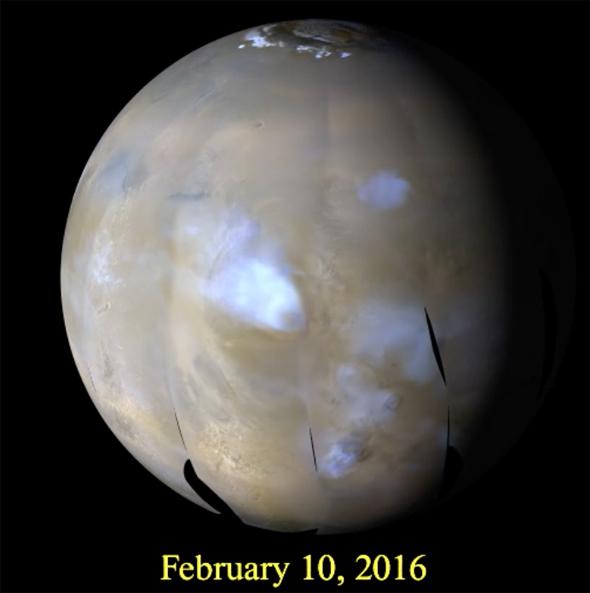It’s another beautiful day on Mars! Highs in the lower -20s C, brisk winds from the southeast over most of Acidalia, low fog in Chryse Planitia, and upper-level orographic clouds off the Tharsis shield. Dress warmly and make sure that airlock’s tightly sealed behind you!
Oh, that Red Planet. Even after all these years part of my brain still thinks of it as relatively dead, unchanging, rocky and dusty, and just sitting there.
But that’s really unfair. A lack of liquid surface water doesn’t mean the planet is boring. It has an atmosphere, and even though it’s less than 1 percent the pressure of Earth’s at sea level, there’s enough there to support weather. Actual, real weather.
Don’t believe me? Then soak in this phenomenal animation of images of Mars taken over the course of a few days from orbit, showing the planet’s ever-changing meteorology:
The images were taken from Feb. 8–14 by the Mars Color Imager on board the Mars Reconnaissance Orbiter. This camera is designed to get wide-angle shots of the planet in order to keep track of its weather on daily, weekly, and even yearly timescales. It watches for water vapor and frost, ground ice, CO2 frost, and even ozone.
It observes the planet in two different wavelengths (colors) of ultraviolet and five in visible light. It uses what’s called a push-frame technique*; the detector is a rectangle that is very narrow in one direction but wide in the other (like a long ribbon), with the color filters bonded onto the detector itself. As MRO circles the planet, a color image of each part of Mars is built up in strips and can be assembled into a single color image. A lot of Earth-observing satellites use a similar technique (called pushbroom, using a single long strip of pixels), and it was even used on the New Horizons Pluto probe to create a psychedelic animated map of that tiny, distant world.
This technique is pretty efficient; you can build a smaller detector that saves mass, money, and time. Do you have a flatbed scanner in your house? They use this method too! Incidentally, the black regions in the animation are due to times when the orbiter shifts its angle or loses data, preventing it from seeing certain areas at different times.
I love the views it gets, especially of the volcanoes. Tharsis shield is a huge bump in the side of Mars, an uplifted region with three volcanoes along a line, and the giant Olympus Mons off to the side. As wind blows air up the sides of the mountains it cools and water vapor condenses, forming what are called orographic clouds. Living on the lee side of the Rocky Mountains here on Earth I see clouds like this all the time.
See the clouds running all along the equator? That’s called the aphelion cloud belt. The orbit of Mars is more elliptical than Earth’s, and when Mars is farthest from the Sun—the point in its orbit called aphelion, when it’s about 250 million kilometers from the Sun, compared with 150 million for Earth—it’s significantly colder than when it’s closest to the Sun (which is at a distance of about 205 million kilometers). That equatorial belt of clouds forms at aphelion, and may affect the Martian climate. As it happens, Mars is near aphelion now.

NASA/JPL-Caltech/Malin Space Science Systems
The folks who run the MARCI camera have a convenient map on their page to help you identify various geographic features. What else can you spot? You can also grab animations going back to 2007. Amazing.
And I can’t help but think: If we have this tech now, today, then it seems that the Ares 3 crew would’ve had even better forecasting equipment. Oh Mark Watney, how we failed you!
Tip o’ the spacesuit visor to Andy Britton and Kayla Iacovino.
* Correction, Feb. 26, 2016: I originally wrote that MARCI uses a pushbroom technique, but was informed by Bruce Cantor (Senior Staff Scientist at Malin Space Science Systems, which built MARCI!) that it uses multiple rows of pixels to make smaller subframes, not a single row of pixels.
